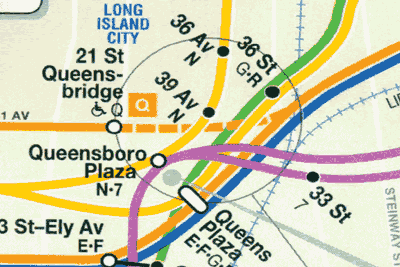63rd St Tunnel Connector
Legislation | Documents/Reports | Links | Press Releases
One of the first major transportation projects I championed as a member of Congress was the 1300-foot 63rd Street Tunnel Connector. The project consisted of ½ mile of new construction and 8 miles of rehabilitation work. Designed to relieve crowding on the E and F lines and make appropriate use of the 63rd Street Tunnel, it was completed in 2001. I worked with my colleagues in the New York delegation, particularly then-Congressman Thomas Manton who brought the idea to President Clinton's attention, to obtain federal funding. With our support, the federal government contributed $306.1 million out of a total project cost of $645 million.
© Metropolitan Transportation Authority
The 63rd Street Tunnel Connector was designed to make use of the 63rd Street Tunnel built under the East River during the 1970s as part of a project to expand subway service in Queens. Although the Tunnel itself was completed in 1973, construction on other aspects of the line, verifying the tunnel's viability and other matters slowly continued until 1989 when the tunnel finally opened, having cost $868 million (roughly half of which was paid by the federal government). The tunnel was dubbed the "Tunnel to Nowhere" because all it did was bring passengers one stop into Queens. All that had been built of the new subway line to Queens were three new stations at 53rd Street and Lexington Ave, on Roosevelt Island and at 21st Street and 41st Avenue in Long Island City.
The Tunnel consists of two levels – an upper level for subway service and a lower level built to provide LIRR service to Grand Central Terminal (East Side Access). The 1300-foot Tunnel Connector allowed the MTA to bring the Queens Boulevard line (the F train) through the Tunnel's upper level, enabling the MTA to increase the number of trains between Queens and Manhattan by 20% -- about 17 an hour during rush hour -- thereby helping to relieve congestion on existing subway lines. Subway trains began running through the Tunnel Connector on December 16, 2001. The Tunnel's lower level has never been used for train service. It is expected to accommodate LIRR trains to Grand Central Terminal once East Side Access is completed.
History
- The original tunnel was partially built with funds from a 1967 bond issue, and partially with federal funds (roughly half of the cost was paid by the federal government). Construction began in November 25, 1969.
- By the time the project was halted, it was 7 years behind schedule and cost 3 times its original estimate.
- The 63rd Street tunnel was designed in conjunction with the 2nd Avenue Subway and both were expected to be completed at approximately the same time in the 1970s.
- On October 29, 1989, the MTA began running trains into the 21st Street and 41st Avenue station in Queens using the 63rd Street Tunnel. By that time, the MTA had spent, $898 million on the ‘Tunnel to Nowhere.’
- Construction of the 63rd Street Tunnel Connector started in September 1994 and was completed in 2001.
- The Connection is currently served by the "F" train connecting Queens and Manhattan.
- The V, a brand-new train line, was added along Queens Boulevard as a local along the route the F once took.
What the Project Entailed
The Connector project actually consisted of several tasks involving significant engineering challenges:
- Extensive rehabilitation of eight miles of the existing 63rd Street tunnels, including new signals and track crossovers.
- Extending both levels of the 63rd Street tunnel 1300 feet and joining the upper level to existing subway lines by means of new ramps; the lower level, belonging to the LIRR, was extended as MTA proceeded with plans to connect this tunnel to the LIRR's Main Line and Port Washington Branch (East Side Access).
- Widening the main Queens Boulevard corridor line between 33rd and 36th Street to six tracks; two of these tracks being ramps that enter below the main line and rise to switches west of 36th Street station, allowing trains to access either local or express tracks.
- Constructing diversion tunnels to allow existing subway services to continue operating without interruption.
- Tunneling 20 feet under the Northern Boulevard subway, and underpinning the existing Northern Boulevard roadway, buildings and express tracks. This required the contractors to cut deep shafts through 140 ft. of rock after slurry walls were built. The new tunnels then had to penetrate an inverted concrete plug.
- Providing up to 90-foot wide temporary roadway surfaces to allow automobiles to operate unimpeded.
- Integrating two four-story, 8,000 square foot ventilation buildings located at 29th Street and 39th Street.
- Lowering a sewer siphon 50 feet to make room for a new tunnel.
- Mitigation of significant ground water.
- Constructing a new TA employee facility.


